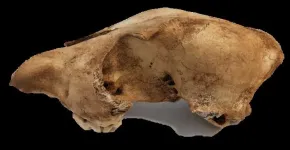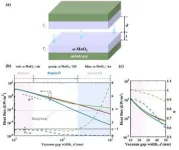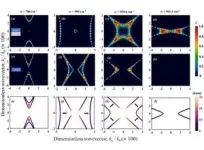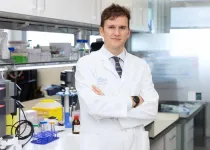(Press-News.org) DNA from fossilised dingo remains going back 2746 years compared with modern dingoes’
Dingos arrived in Australia more than 3000 years ago
K’gari dingoes have no domestic dog ancestry – they are pure dingo
Co-lead author, paleogeneticist Dr Sally Wasef, from QUT’s School of Biomedical Sciences said this dataset gave a rare glimpse into the pre-colonial genetic landscape of dingoes, free from any mixing with modern dog breeds.
“Consequently, are behaviourally, genetically, and anatomically distinct from domestic dogs,” Dr Wasef said.
“Modern-day dingoes’ ancestors arrived in Australia more than 3000 years ago, most likely transported by seafaring people.
“The samples we analysed represent the oldest ancient DNA recovered in Australia and indicate broad possibilities of future DNA and conservation work that could be carried out on dingoes and other animals.
“Dingo populations are classified into east and west groups which were previously thought to have formed during post-colonial human activity.
“Our findings show, however, that dingoes’ population structure was already in place thousands of years ago and clarify the genetic heritage of dingoes, while highlighting the importance of using ancient DNA for wildlife conservation.
“For example, all K’gari dingoes we analysed do not have any domestic dog ancestry, proving they preserve their full ancestral heritage.
“Although we studied only a small number of K’gari dingoes, our findings highlight the importance and usefulness of our pre-colonial ancient genomic data to conserving our unique native animals.
“Due to poor human behaviour that causes some dingoes to become habituated to seeking food from tourists, several problem dingoes have been culled, which is concerning given their small population size.”
Co-lead author Dr Yassine Souilmi, from the University of Adelaide’s Australian Centre for Ancient DNA and Environment Institute, said the unique dataset of ancient dingo DNA had helped to uncover crucial details about the ancestry and migration patterns of the modern-day dingo.
"Dingoes had distinct regional populations, split roughly along the Great Dividing Range, long before the European invasion of Australia, and certainly predating the dingo-proof fence,” Dr Souilmi said.
“The DNA analysis also showed less interbreeding between dingoes and modern dogs than was previously thought, with our research confirming today's dingoes retain much of their ancestral genetic diversity.
“Dingoes hold significant cultural importance to Aboriginal and Torres Strait Islander peoples and play an essential role in the Australian ecosystem.
"Understanding their historical population structure helps us preserve the dingo's role in Australian ecology and culture.
“Dingoes are currently under threat from lethal culling programs, and our research highlights the importance of protecting populations in national parks and beyond.”
Ancient genomes reveal over two thousand years of dingo population structure was published in PNAS.
END
Ancient dingo DNA shows modern dingoes share little ancestry with modern dog breeds
2024-07-08
ELSE PRESS RELEASES FROM THIS DATE:
New director appointed to lead U.S. Department of Energy’s Jefferson Lab
2024-07-08
NEWPORT NEWS, VA – Jefferson Science Associates, LLC, today announced that Kim Sawyer will become the new director of the U.S. Department of Energy’s Thomas Jefferson National Accelerator Facility, effective Aug. 2.
Sawyer will serve as the lab’s fifth director in its 40-year history. In this role, Sawyer will be responsible for leading all activities in support of the world’s premiere research institution for exploring the nature of matter.
“We are pleased that Kim has been selected to lead Jefferson Lab,” said ...
Almost half of US counties have no cardiologists despite higher prevalence of CV risk factors, mortality
2024-07-08
Disparities in cardiovascular disease outcomes between urban and rural areas continue to widen, yet nearly half of U.S. counties do not have a practicing cardiologist. According to a new analysis published in JACC, the flagship journal of the American College of Cardiology, these counties tend to be more rural and socioeconomically disadvantaged, with a greater burden of cardiovascular disease, thus highlighting deep geographic disparity in access to cardiovascular care.
“While cardiologists are not the only determinants of cardiovascular outcomes, the lack of access to cardiologists in areas with ...
Americans find hospital-at-home care appealing and safe
2024-07-08
Hospital-level care provided in a patient’s own home is appealing to a majority of people for its convenience, comfort and effectiveness, according to a USC Schaeffer Center study.
The study, published in JAMA, found that most survey respondents felt they would recover faster if cared for at home, rather than in the hospital, and that they felt safe being treated at home.
Researchers say their study provides important insights about patient and family preferences as policymakers weigh whether to extend ...
A gut microbe could hold a key to help people benefit from healthy foods
2024-07-08
KEY TAKEAWAYS
In a study involving 50,000+ individuals from around the world, higher gut levels of Blastocystis, a single-celled organism commonly found in the digestive system, were linked to more favorable indicators of health.
People with a healthy diet had higher levels of Blastocystis.
The study, which was conducted by an international team led by investigators at Massachusetts General Hospital, suggests that Blastocystis may play a beneficial role in how diet impacts health.
In an analysis of more than 50,000 individuals from around the world, carriers of gut Blastocystis, a single-celled organism that has been ...
Luther identifying road segments that bisect predicted movement corridors for small priority species in Virginia
2024-07-08
David Luther, Associate Professor, Biology, received funding for the project: “Identifying Road Segments that Bisect Predicted Movement Corridors for Small Priority Species in Virginia.”
The purpose of this study is to advance the work of the legislated Wildlife Corridor Action Plan (WCAP) and meet the intent of an awarded Federal Highway Administration (FHWA) grant by identifying road segments that may pose a high risk or impede movement of select small terrestrial and semiaquatic animal species that are ...
Employees prefer human performance monitors over AI, study finds
2024-07-08
ITHACA, N.Y. - Organizations using AI to monitor employees’ behavior and productivity can expect them to complain more, be less productive and want to quit more – unless the technology can be framed as supporting their development, Cornell University research finds.
Surveillance tools cause people to feel a greater loss of autonomy than oversight by humans, according to the research. Businesses and other organizations using the fast-changing technologies to evaluate employee behaviors should consider their unintended consequences, which may prompt resistance and hurt performance, the researchers say. They also suggest an opportunity to win buy-in, ...
Novel liquid biopsy methodology enables the monitoring of disease evolution in patients with metastatic prostate cancer
2024-07-08
Novel liquid biopsy methodology enables the monitoring of disease evolution in patients with metastatic prostate cancer
Extracellular vesicles shed by prostate cancer cells to the bloodstream contain tumor-derived material that can be used as biomarkers of therapy response and resistance in patients with metastatic disease.
Published today in the journal Cancer Cell, results of a VHIO-led study show that a newly developed liquid biopsy-based approach can monitor tumor gene expression through RNA contained ...
Schrag studying history Of Dulles Corridor Metrorail Project
2024-07-08
Zachary Schrag, Professor, History and Art History, College of Humanities and Social Sciences (CHSS), received funding for the project: “Rail Against Sprawl: A History of the Dulles Corridor Metrorail Project.”
Schrag said, “I am writing the history of the Dulles Corridor Metrorail Project, among the nation’s most ambitious efforts to reshape daily transportation choices. After decades of planning and construction, the project was completed in 2022, extending the Washington ...
Study identifies racial and gender disparities in youth psychiatric emergency department boarding
2024-07-08
A new study led by researchers at McLean Hospital and Harvard Medical School, in collaboration with researchers from Massachusetts General Hospital and Cambridge Health Alliance, has uncovered concerning disparities in boarding rates of children and adolescents with severe mental health symptoms in emergency departments.
When reviewing more than 4,900 boarding episodes of youth under 17 years old in Massachusetts over an 18-month period, the researchers found there were numerous racial and gender disparities: Black youth were less likely to be admitted to inpatient psychiatric care than White youth. Additionally, transgender and nonbinary youth experienced ...
Raw milk is risky, but airborne transmission of H5N1 from cow's milk is inefficient in mammals
2024-07-08
While H5N1 avian influenza virus taken from infected cow’s milk makes mice and ferrets sick when dripped into their noses, airborne transmission of the virus between ferrets — a common model for human transmission — appears to be limited.
These and other new findings about the strain of H5N1 circulating among North American dairy cattle this year come from a set of laboratory experiments led by University of Wisconsin–Madison researchers, reported today in the journal Nature. Together, they suggest that exposure to raw milk infected with the currently circulating virus poses a real risk of infecting humans, but that the virus may not ...





